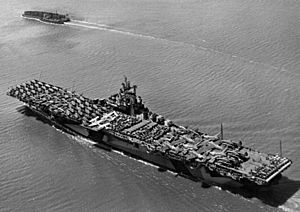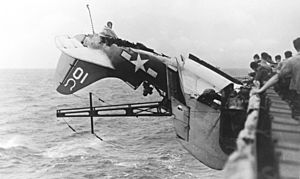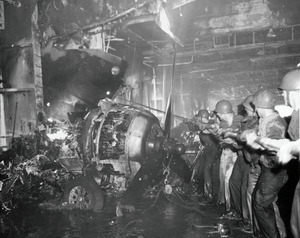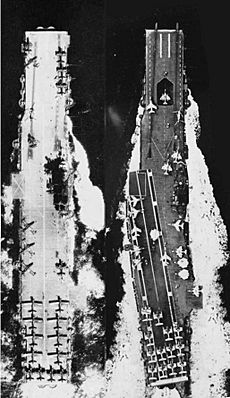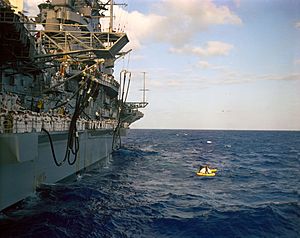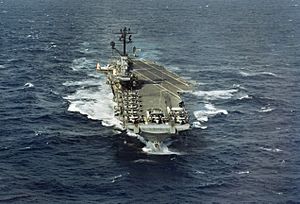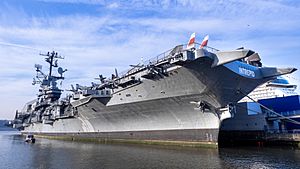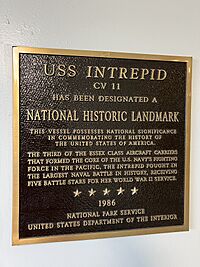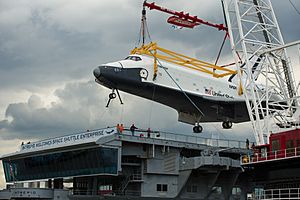USS Intrepid (CV-11) facts for kids
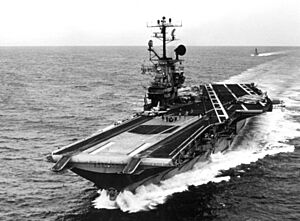
USS Intrepid on 17 October 1968
|
|
Quick facts for kids History |
|
|---|---|
| Name | Intrepid |
| Namesake | USS Intrepid (1904) |
| Ordered | 3 July 1940 |
| Builder | Newport News Shipbuilding |
| Laid down | 1 December 1941 |
| Launched | 26 April 1943 |
| Commissioned | 16 August 1943 |
| Decommissioned | 15 March 1974 |
| Reclassified |
|
| Stricken | 23 February 1982 |
| Motto | In Mare In Caelo "On the sea, in the sky" |
| Status | Museum ship at the Intrepid Museum in New York City |
| General characteristics | |
| Class and type | Essex-class aircraft carrier |
| Displacement | |
| Length |
|
| Beam | 93 ft (28.3 m) |
| Draft | 34 ft 2 in (10.41 m) |
| Installed power |
|
| Propulsion |
|
| Speed | 33 knots (61 km/h; 38 mph) |
| Range | 14,100 nmi (26,100 km; 16,200 mi) at 20 knots (37 km/h; 23 mph) |
| Complement | 2,600 officers and enlisted men |
| Armament |
|
| Armor | |
| Aircraft carried |
|
The USS Intrepid (CV/CVA/CVS-11) was a famous aircraft carrier that served in the United States Navy. It was one of 24 Essex-class carriers built during World War II. The ship was nicknamed "The Fighting I" because of its bravery in battle. It was also sometimes called "Decrepit" or "the Dry I" due to needing frequent repairs after being hit by torpedoes and kamikaze planes.
The Intrepid was launched in 1943 and played a big role in several battles in the Pacific Ocean during World War II, including the Battle of Leyte Gulf. After the war, it was updated and served again, first as an attack carrier and then as an anti-submarine carrier. It even helped recover astronauts from space missions!
Today, the USS Intrepid is a museum ship in New York City. It is the main part of the Intrepid Sea, Air & Space Museum, where visitors can explore its history and learn about sea, air, and space travel.
A Look at Intrepids History
The Intrepid began its journey on December 1, 1941, when its keel was laid down at a shipyard in Newport News, Virginia. This was just days before the Japanese attack on Pearl Harbor, which brought the United States into World War II. The ship was officially launched on April 26, 1943, and joined the Navy on August 16, 1943. After training in the Caribbean, it sailed to the Pacific Ocean to join the fight against Japan.
World War II Battles
Fighting in the Central Pacific
In January 1944, the Intrepid joined other carriers to attack islands in the Kwajalein Atoll. Their planes destroyed many Japanese aircraft and helped Marines land on the islands. This was part of the "island-hopping" strategy to move closer to Japan.
After Kwajalein, the Intrepid took part in Operation Hailstone, a big attack on the main Japanese naval base at Chuuk Lagoon. From February 17 to 19, the carriers bombed Japanese forces, sinking many ships. However, the Intrepid was hit by a Japanese torpedo on the night of February 17. The torpedo damaged its rudder and caused flooding, killing 11 sailors. The crew had to use a makeshift sail to get the ship back to Pearl Harbor for temporary repairs. Later, it went to San Francisco for full repairs.
Battles in the Philippines
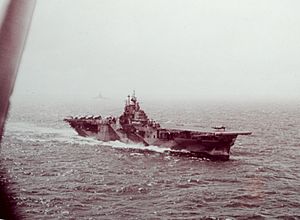
By September 1944, the Intrepid was back in action, attacking Japanese airfields in the Caroline Islands and the Philippines. These attacks helped prepare for the Philippines campaign. On October 20, the Intrepid launched planes to support Allied troops landing on Leyte island.
From October 23 to 26, the Intrepid was involved in the huge Battle of Leyte Gulf. Its planes attacked Japanese ships, including the giant battleship Musashi, hitting it with bombs and torpedoes. The Musashi was eventually sunk. The Intrepid also helped sink four Japanese aircraft carriers in the Battle off Cape Engaño.
The Intrepid faced danger during these battles. On October 29, a Japanese kamikaze plane crashed into the ship, killing ten men. On November 25, two more kamikazes hit the Intrepid, killing 69 men and starting a large fire. Despite the damage, the crew put out the fires, and the ship continued its mission before heading back for repairs.
Final Attacks on Japan
In February 1945, the Intrepid returned to the Pacific. It launched strikes against Japanese airfields on Kyūshū and attacked Japanese ships at Kure. On March 18, another kamikaze plane exploded near the Intrepid, causing fires on the hangar deck, but the crew quickly put them out.
The carrier then moved to support the invasion of Okinawa. Its planes attacked targets on the island and Japanese airfields. On April 16, a Japanese plane crashed into the Intrepid's flight deck, killing eight men. But again, the crew quickly controlled the damage, and planes were landing on the carrier within hours.
After more repairs, the Intrepid launched its last strikes against Japanese forces on Wake Island on August 6. On August 15, 1945, the Japanese surrendered, and the Intrepid was ordered to stop offensive operations. It helped with the occupation of Japan before returning home in December 1945.
Life After World War II
Becoming an Attack Carrier
The Intrepid was taken out of service in 1947. However, it was brought back in 1952 and sent to Norfolk, Virginia, for a big upgrade called SCB-27C. This modernization allowed it to operate new jet aircraft. It was reclassified as an attack carrier (CVA-11). In 1954, it became the first carrier to launch planes using American-built steam catapults.
Serving in the Atlantic
Between 1955 and 1961, the Intrepid served mainly in the Atlantic Ocean and the Mediterranean Sea. It took part in Operation Strikeback in 1957, which was the largest peacetime naval exercise at that time. It also helped study how wind affects aircraft launches, proving that carriers could launch planes even when sailing downwind.
Space Mission Recoveries
In 1961, the Intrepid was reclassified again, this time as an anti-submarine warfare carrier (CVS-11). In 1962, it was chosen to recover astronaut Scott Carpenter and his Aurora 7 space capsule from the Project Mercury mission. Helicopters from the Intrepid picked up Carpenter after he splashed down in the ocean.
In 1965, the Intrepid was again a recovery ship, this time for Gemini 3, the first manned Gemini flight. Astronauts John Young and Gus Grissom splashed down near the Intrepid and were flown to the ship for medical checks. The Intrepid then retrieved their spacecraft, Molly Brown.
Vietnam and NATO Operations
From 1966 to 1969, the Intrepid completed three tours of duty off Vietnam, supporting combat operations. Its planes launched bombs and rockets against targets. In 1966, one of its propeller-driven planes even shot down a Vietnamese MiG-17 jet!
In the early 1970s, the Intrepid took part in NATO exercises in the North Atlantic and Mediterranean. It conducted submarine detection operations, sometimes under the watchful eyes of Soviet forces.
The USS Intrepid was finally taken out of service for good on March 15, 1974.
Intrepid as a Museum Ship
After its long service, the Intrepid was almost scrapped. However, a group led by Michael D. Piccola worked to save the carrier. In August 1982, the ship opened as the Intrepid Sea, Air & Space Museum at Pier 86 on the Hudson River in New York City. Four years later, it was recognized as a National Historic Landmark.
The museum has hosted many events, from wrestling matches to press conferences. After the September 11, 2001 attacks, it even served as an operations center for the FBI.
Big Renovations (2006–2008)
In 2006, the Intrepid museum started a major project to restore the ship and improve its exhibits. The museum closed in October 2006 so the Intrepid could be moved for repairs. It took a special dredging operation to clear away years of mud and silt before the ship could be towed away.
The Intrepid received an $8 million interior renovation. Areas like the anchor chain room and crew living quarters were opened to the public for the first time. The entire ship was repainted, and many improvements were made. The total cost of the renovation was $120 million. The Intrepid was towed back to its pier in October 2008 and reopened to visitors in November.
Space Shuttle Enterprise Joins the Museum
On December 12, 2011, the Space Shuttle Enterprise was given to the Intrepid Sea, Air & Space Museum. On April 27, 2012, the Enterprise flew over New York City on its "final tour" before landing at JFK International Airport. It was then moved by barge to the Intrepid Museum on June 6.
The Enterprise went on public display on July 19, 2012, in the museum's new Space Shuttle Pavilion. It is a popular exhibit, allowing visitors to see a real space shuttle up close.
Awards and Honors
The Intrepid earned five battle stars and a Presidential Unit Citation for its service in World War II. It also received three more battle stars for its service in Vietnam.
- Navy Unit Commendation (2)
- Navy Expeditionary Medal
- China Service Medal (extended)
- American Campaign Medal
- Asiatic-Pacific Campaign Medal (5 battle stars)
- World War II Victory Medal
- Navy Occupation Service Medal (with Asia and Europe clasps)
- National Defense Service Medal (second)
- Vietnam Service Medal (3 battle stars)
- Philippine Presidential Unit Citation
- Republic of Vietnam Meritorious Unit Citation (Gallantry Cross Medal with Palm)
- Philippine Liberation Medal
- Republic of Vietnam Campaign Medal
See also
 In Spanish: USS Intrepid (CV-11) para niños
In Spanish: USS Intrepid (CV-11) para niños
- Intrepid Four
- List of aircraft carriers
- List of museum ships
- US Airways Flight 1549


